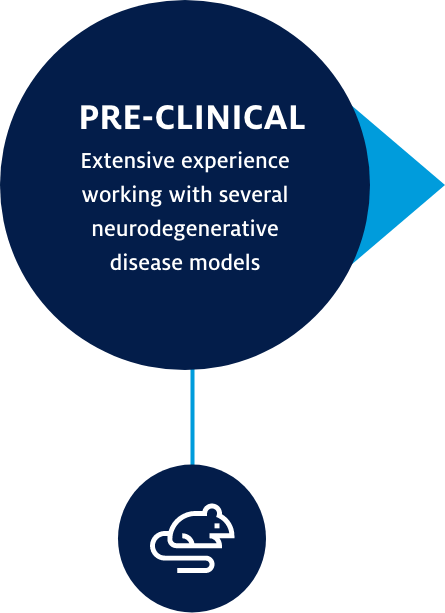

For families and patients wanting more information about Allo Phase 2 Alzheimer’s Clinical Trial: LEARN MORE
Troubled by hot flashes? Learn more about the HF Relief Study being conducted at the University of Arizona to test the effectiveness of a natural product, PhytoSERM, to alleviate hot flashes: hfrelief.org
For information about the PhytoSERM Brain Clinical Trial: LEARN MORE
The Center for Innovation in Brain Science mission is a collaborative, enabling research environment in which innovation is fostered and developed to address a challenge that have global proportions and individual significance: age-related neurodegenerative diseases.
The prevailing paradigm in academic-based therapeutic development is built upon the “bench to bedside” approach, where a discovery in the laboratory is followed by a search for a potential disease application.
Our approach is different.



By reversing the discovery process and beginning at the bedside and moving to the bench, we are creating a highly personalized approach to discovery of mechanisms and therapeutic targets of opportunity.
Age remains the greatest risk factor for neurodegenerative diseases, including Alzheimer’s, Parkinson’s, Multiple Sclerosis and ALS. A critical factor in age-associated vulnerability to disease is that aging occurs at the systems level, which makes single target, single molecule strategies unlikely successful therapeutic solutions.
Using a deep, broad reservoir of expertise, from basic science to translational neuroscience, we are elevating team science and enabling rich collaborations. Age-associated neurodegenerative diseases are multifactorial, complex and dynamic. As the disease progresses, so do pathways that are activated and the multiple systems of biology that interact.
While complex, the etiologies share a number of common features, emergence during aging, a prodromal phase, beginning in late midlife, genetic predispositions, gender differences in prevalence, and an energy crisis in the brain.
The Center for Innovation in Brain Science is uniting neuroscience across disciplines around a common cause while filling a critical gap in translational neuroscience, bringing together the expertise of clinicians and scientists across the spectrum of clinical, informatics, translational, computational modeling and basic neurosciences.
We are a unique hub for research knowledge, technologies, computational resources and integrative collaborations to develop therapeutics for age-related neurodegenerative diseases.
The Center for Innovation in Brain Science (CIBS) at the University of Arizona is using its expertise in translational neuroscience to discover and develop novel therapeutics that address serious unmet medical needs and change the outcome for millions of people and their families living with debilitating neurodegenerative diseases.
The center is rapidly advancing programs across a wide range of neurodegenerative diseases: Alzheimer’s, Parkinson’s, Multiple Sclerosis and ALS. The CIBS collaborative research model integrates discovery, translational and clinical science that enables it to validate targets and generate novel therapeutic candidates selective for proteins that play critical roles in neurodegenerative disease pathways.
We welcome inquiries regarding partnerships.



CIBS is combining cutting-edge behavioral tools to simulate the influence of environmental factors on genetic risks to create novel disease models. Already serving the researchers within CIBS to screen genetic models, we’re seeking out collaborators on campus and beyond to determine common mechanisms between neurodegeneration and other diseases.
With deep expertise in high-throughput behavioral research, the neurobehavioral core at CIBS focuses on cognitive neurobehavioral tests, non-invasive sleep measures, and high-speed gait analyses. We also maintain a focused interest on impaired sleep as it contributes to neurodegenerative diseases and may be used to potentially screen at-risk individuals. Our team has developed a strong phenotyping core that provides CIBS researchers with sensitive, high-throughput tasks such as:
Other available testing includes glucose testing, rotarod, radial arm maze, and Barnes maze.
Within the core, sensitive, high-throughput testing has been streamlined in order, not only to detect subtle changes in longitudinal health but also small variations between strains. With our naturalistic neurobehavioral tasks, we hope to be able to isolate the contributing effect that environmental factors, such as stress and sleep disturbances, have on converting genetic risk factors, such as APOE4 and GBA, into pathology.
To learn more about potential collaborations, contact our Neurobehavioral Core.

We are recruiting predoctoral PhD and MD/PhD trainees across multiple scientific disciplines and employing problem-based learning approaches to solve challenges in AD therapeutic development with emerging tools and techniques. Through these training programs, trainees gain important development and leadership skills necessary to conduct team science and manage multidisciplinary teams in the 21st century.
This program is aligned with the National Alzheimer’s Project Act (NAPA), with the goal of filling critical gaps that exist for Alzheimer’s disease (AD) translational research in academic graduate programs.
> cultivate the ability to creatively and collaboratively solve problems working with experts across the translational landscape as part of large-scale team science;
> gain an applied understanding of how data science, particularly using data generated by AMP-AD, M2OVE-AD and ADNI, can accelerate translational research and provide avenues to novel therapeutic insights;
> connect genotypic and phenotypic variations and multi-faceted etiology of AD to therapeutic targets;
> acquire essential professional and business skills to navigate a diverse funding landscape and translate discoveries into the clinical setting.